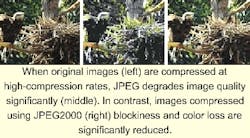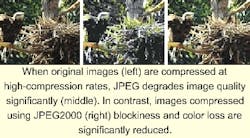Wavelets hold the key to JPEG2000 compression
By offering multiresolution image representation, compression efficiency at low bit rates, lossy to lossless progression, and embedded bit-stream architecture, the wavelet transform provides numerous benefits over its discrete-cosine-transform-based rivals. As a result, it has been recognized as the preferred tool for image and video compression and is a building block of the JPEG2000 standard—Part 1 was finally accepted last January.
Even before this standard, several companies had already incorporated wavelet compression into their software packages. These companies include Aware (Bedford, MA), Summus (Rayleigh, NC), Image Power (Vancouver, BC, Canada), LuraTech (Menlo Park, CA), and Lizardtech (Seattle, WA). Some of these companies have announced JPEG2000-compatible products.
Last year, Adolf Knoll, deputy librarian of the National Library of the Czech Republic in Prague, set out to determine the most effective wavelet software for still images. Although Knoll did not consider MrSID from Lizardtech in his analysis, he concluded that the LuraWave format (LWF) encoded in Laura Document Format (LDF) was the best choice (www.nkp. cz/start/knihcin/digit/vav/wavelet/Efficiency-of-wavelet-conversion.html). "Taking into consideration the fact that LuraTech's LWF 3.0 will be compatible with JPEG2000, it seems that LWF (applied in LDF) will be a good solution for access and delivery of high-quality images," he reports.
At the recent AIIM show (New York), LuraTech demonstrated LuraWave JP2, a beta version of LuraTech's JPEG2000 implementation based on the company's LuraWave technology. LuraWave JP2 is currently available to developers for testing in software-development kits for Windows 98/ME/NT/2000 or as an Adobe Photoshop plug-in.
Image Power and Aware have also released JPEG2000-compatible software. Image Power's JPEG2000 enabled version of its Power Compressor software tool targets image management, archiving, and publishing. The company also offers a JPEG2000 ActiveX control for viewing JPEG2000 images in Internet applications.
Because JPEG2000 uses a layered file structure that allows for progressive transmission and rendering of images, a client can display an image quickly by decoding only the received portion of the image. This is shown on the Web site of Aware (www.aware. com), where images are dynamically increased from small thumbnails to full resolution using the company's JPEG2000 codec.
Motion JPEG2000 (MJP2)—a standard for image sequences that allows JPEG2000-compressed image sequences to be stored in the Motion JPEG2000 file format (MJ2)—still awaits standardization. For interoperability between JPEG2000 and MPEG, Motion JPEG2000, when finalized later this year, will be compatible with the JPEG2000 file format (JP2) and the MPEG-4 file format (MP4). In addition, Motion JPEG2000 will also support both lossless and lossy compression in a single codec.

